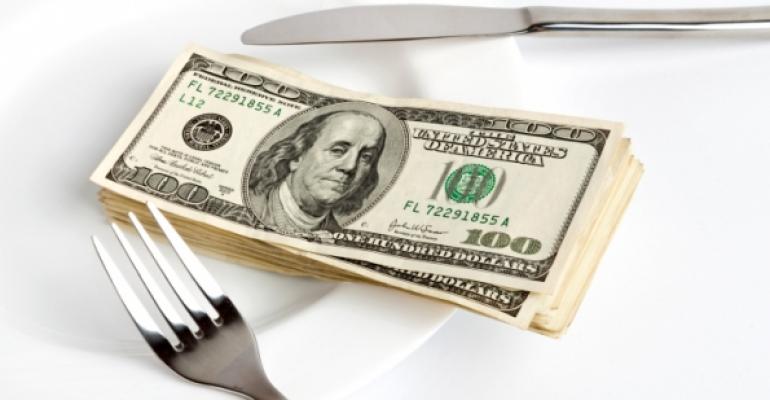Median U.S. household income fell about $4,500, from $56,436 to $51,939, between 2007 and 2013, while commodity prices have soared around 20 percent in just the past two years.
Those disheartening stats, relayed by panel moderator John Barone, president of Market Vision and columnist for Nation’s Restaurant News, set the stage for “Margin Mania,” a panel discussion at MUFSO on how foodservice operators can overcome the twin scourges of reduced consumer spending dollars and rising food costs.
Brinker International senior vice president of supply chain David Parsley is leading the way in making a case for overhauling how the problem “holding back the tide” of escalating product prices can be approached from the supply chain. Parsley stressed the need to look at opportunities beyond the obvious when examining one’s organization.
“The problem is that many organizations think supply chain just means purchasing, but the reality is that it’s a process that reaches across multiple departments,” he said.
That kind of compartmentalized thinking is bred by spheres of individual experience and comfort zones, Parsley added.
“We tend to look at things functionally because most of us have degrees in specific fields like marketing or operations,” so supply chain comes to be seen as “the procurement department’s problem,” he said.
Brinker has made an ongoing effort to bring a “triad approach” to the problem, with the culinary, procurement and quality assurance teams working collaboratively on menu development before taking it to marketing and operations. This has led to menu offerings that are attractive to customers but also efficient to procure and produce.
The results of the new collaborative approach have been encouraging, Parsley said. Brinker’s food costs have remained relatively flat despite the upward pressure of commodity prices.
“When the cheese market hit $2 everyone said ‘Don’t worry, it can’t last,’ and then it went to $2.40,” he said.
Hard Rock Café vice president and COO for company café operations Fred Thimm described the chain’s journey to more efficient menu development through a comprehensive soup-to-nuts menu review.
“The goal was to remain food-cost-neutral while increasing guest satisfaction,” Thimm said.
That isn’t the easiest task at a venerable organization like Hard Rock, where certain menu items achieve iconic status among decision-makers even if they should be reconsidered objectively.
“We tried to be as fact-based as possible” in the menu review, Thimm said, noting that the company used its own in-house analytical tool and field-tested extensively, with more than 3,000 detailed guest surveys.
The result has been a refreshed menu that modestly reduced the number of items from 61 to 55 offerings, and featured an upgraded selection in the key burger category. Another menu modification based on the review is already ready for rollout.
Two representatives from the onsite dining community rounded out the panel. Art Dunham, food service director for Pinellas County Public Schools in Florida, discussed a program that added half a million dollars to the department’s bottom line while also helping to encourage children to eat fruits and vegetables. The program, which uses vegetables like sweet potatoes and spinach mixed with fruits and juices in various smoothie blends, has proved very popular in the district’s middle schools. Pinellas County Public Schools won a Food Management Best Concept Award this year for its efforts.
Another Best Concept winner, Parker Adventist Hospital nutrition and environmental services director Lisa Poggas, detailed how her nutrition services department has to maximize the efficient use of labor across multiple disciplines. One vehicle is a new multiplatform production operation, the Best-Concept-winning Manna, where one kitchen serves a full-service restaurant, a convenience-store foodservice operation and a room-service-based patient dining operation.
Contact Mike Buzalka at [email protected].
MUFSO title sponsors are American Express; The Coca Cola Company; and International Franchise Association.
Keynotes/general sessions are presented by: e*Restaurant from Altametrics; Pro*Act; Red Book Connect; SurveyMini by SMG and the Texas Restaurant Association.
Pillar sponsors include: Idahoan Foods, Sweet Street Desserts and Ventura Foods (Culinary); Red Book Connect (Entrepreneur); Smithfield Farmland (Ideas); and Fishbowl, MomentFeed, Paytronix and Single Platform from Constant Contact (Marketing).
The Monday night awards reception is sponsored by: Avocados from Mexico; Daiya Foods; Ovention; Sara Lee Foodservice; Segafredo Zanetti and Texas Pete®.
Coca Cola presents the Shake, Sparkle & Stir event, and Texas Pete® is sponsoring the MUFSO Kitchen Hero Cook Off, benefitting Share Our Strength’s No Kid Hungry Campaign.
Hot Concept/Best Concepts Celebration is sponsored by e*Restaurant from Altametrics; Golden Chain Awards are sponsored by SurveyMini by SMG.
MUFSO App is sponsored by Qualisoy; MUFSO WiFi is sponsored by ROSnet; and Conference Pen is sponsored by CSM Bakery Products.
Refreshment breaks are sponsored by Royal Cup Coffee and Wrigley Foodservice.

